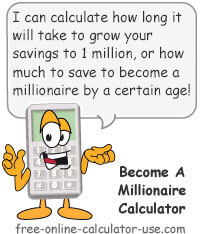IMPORTANT: Numeric entry fields must not contain dollar signs, percent signs, commas, spaces, etc. (only digits 0-9 and decimal points are allowed).
Click the Terms tab above for a more detailed description of each entry.
Step #1:
Enter your current age.
Step #2:
Enter the age you wish to become a millionaire by (retirement age, etc.).
Step #3:
Enter the amount you currently have saved toward becoming a millionaire. If none, enter 0 or leave blank.
Step #4:
Enter the average percentage rate of return you expect to earn on your savings.
Step #5:
Select the deposit frequency (how often you will be making a deposit to the account).
Step #6:
Enter the amount you plan to deposit at the selected frequency.
Step #7:
Click the "Calculate MillionCalculate Millionaire StatsCalculate Millionaire StatsCalculate When You Will Be A Millionaire" button. This will display the future value at your target age, the years it will take to become a millionaire, and a year-by-year savings growth chart.


Follow me on any of the social media sites below and be among the first to get a sneak peek at the newest and coolest calculators that are being added or updated each month.